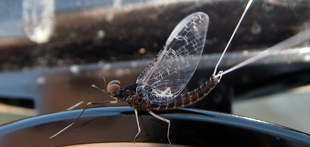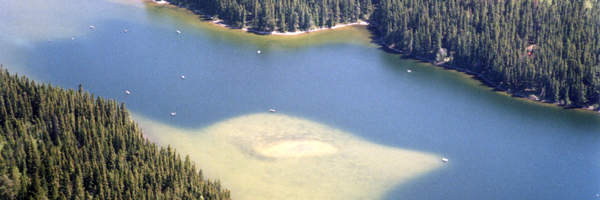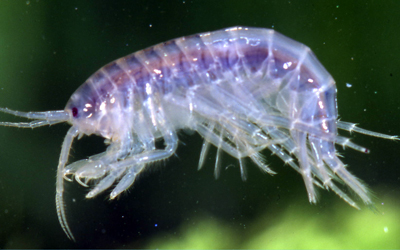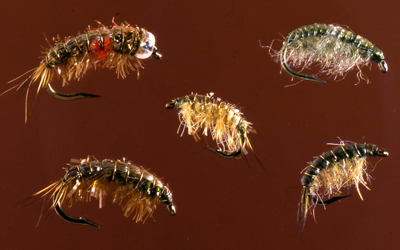|
|
|
Hatches - Shrimp (Scuds)Introduction
The presence of shrimp or scuds in a lake or stream tells us a lot about the relative productivity of that water body. Freshwater shrimp flourish in nutrient rich, alkaline waters. Shrimp require high levels of dissolved calcium in the water in order to develop and maintain their chitinous exoskeleton which frequently sheds. Aquatic environments that support populations of shrimp will also be home to a variety of other aquatic invertebrates including mayflies, midges, damselflies, caddisflies, dragonflies, and stoneflies, all of which are prominent trout food sources. This nutrient rich water provides ideal growing conditions for a variety of submergent and emergent aquatic plants. The submergent vegetation offers prime habitat for shrimp as well as many other invertebrates and fish.
Freshwater shrimp or scuds can make up a significant portion of the diet of trout in productive stillwaters and spring creeks. They are often referred to as a "meat and potatoes" food source due to their abundance and constant availability to trout. Shrimp may not be the main course each and every day but they can make up over 60% of the annual diet of the trout living in a particular lake or reservoir.
Life Cycle
Freshwater shrimp or scuds are members of the Class Crustacean, Order Amphipoda. Worldwide, there are about 800 freshwater species. Representatives of two families, Gammarus and Hyalella are common to many North Temperate freshwater ecosystems. Gammarus can reach in excess of 20 mm in length while Hyalella are much smaller, seldom attaining 5 mm in body length. Both genera can be found in the same water body but Hyalella can survive in a much broader range of water chemistry conditions.
Prime scud habitat is the thick mats of vegetation that cover the benthic areas of the shallow shoal or littoral zone of the lake or stream.
Scuds have a simple life cycle with reproduction and growth occurring within the same general habitat. They do not go on mating swims or migrations unlike many other aquatic invertebrates. Mating can occur several times during the late spring to fall months with water temperature having the most influence on the initiation of mating courtship.
During reproduction, the females will often be carried on the backs of the males. Females can release several to over 50 eggs per brood. The eggs are carried in a brood pouch or marsupium located on the underside of the thorax area. Fertilized eggs are typically bright orange in colour.
Fishing Tactics
Freshwater shrimp make up a significant portion of the annual diet of trout in stillwaters as well as in productive streams and spring creeks. Trout eat them because of their abundance and availability on a year round basis. Shrimp or scuds are also a relatively easy food source to capture, as they are not fast swimmers and spend their time hiding amongst the vegetation or other bottom structure. Trout hunt them down by cruising through and around the lush mats of vegetation that grow along the bottom of the shallow water areas of the lake. This means the trout are feeding in water less than about 7 metres in depth and in most situations in less than 4 metres deep.
Scud patterns can be effectively fished with both floating and sinking fly lines. The goal with either setup is to present the fly as close to the bottom vegetation or other structure as possible. Weighted shrimp patterns are very effective when used with floating fly lines. Use a leader that is at least 25% longer than the depth you are fishing to ensure your fly can reach the bottom zone prior to beginning a retrieve. Intermediate or slow sinking fly lines and 3 to 4 metre long leaders are the other presentation worth trying. Make sure to wait long enough before initiating a retrieve as you want the fly as close to the lake bottom as possible. Take the sink rate of the fly line (inches/second) and the depth being fished to determine how many seconds it will take to get down to the desired depth zone.
A slow, 5 to 15 cm long strip retrieve interspersed with regular 2 to 5 second pauses is a good imitation of the swimming action of shrimp. Capture a few shrimp with a small aquarium net so that colour and size can be matched as closely as possible. A Duncan loop knot or a non-slip loop knot will provide your fly with a lot more natural movement when retrieved through the water.
|
|
|
STILLWATER SEMINARS * GUIDING * HOSTED TRIPS
HATCHES:::Shrimp
|
|
|||||
 |
|
 |
|||
|
|








